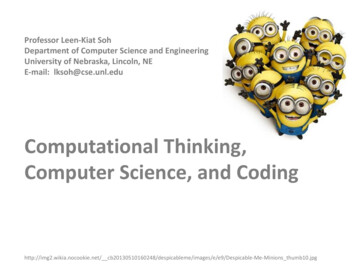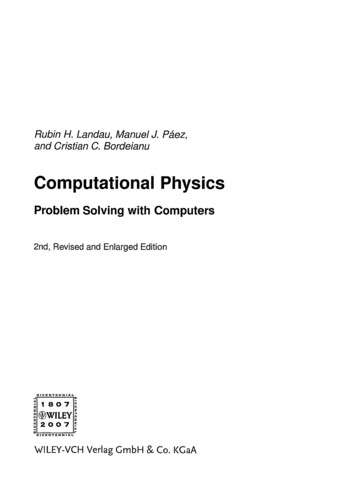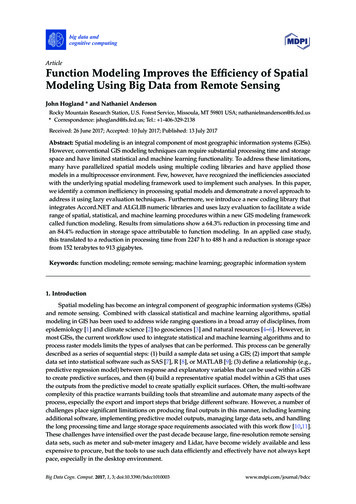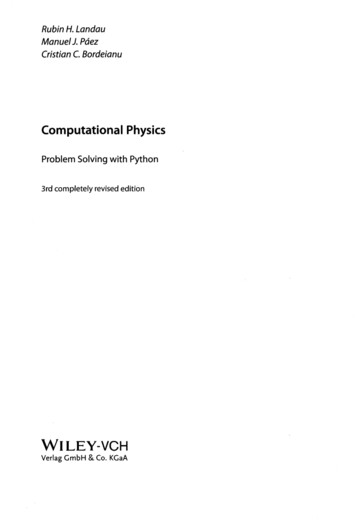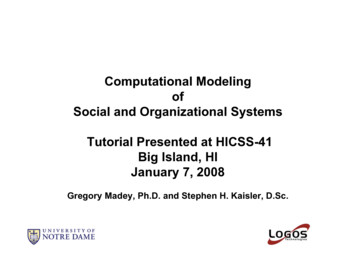
Transcription
Computational ModelingofSocial and Organizational SystemsTutorial Presented at HICSS-41Big Island, HIJanuary 7, 2008Gregory Madey, Ph.D. and Stephen H. Kaisler, D.Sc.
Who we areπSteve KaislerLogos Technologies, Inc3811 N. Fairfax DriveArlington, VA 22203W: 703-584-5840C: 240-593-0980skaisler1@comcast.netπGreg MadeyAssociate ProfessorDept. of Computer Science andEngineeringUniversity of Notre DameNotre Dame IN 46556Source: Popp 2005W: (574) 631-8752gmadey@nd.eduHICSS-41 CMSOS Copyright 2007 Steve Kaisler/Greg MadeyCMSOS-2
AgendaI.SessionTimeIntroduction to Computational9:00 – 10:15Social ScienceBreakII.Hidden Markov Models10:45 – 12:00LunchIII.Social Network Analysis1:00 – 2:15BreakIV.Agent-Based Simulation2:45 – 4:00HICSS-41 CMSOS Copyright 2007 Steve Kaisler/Greg MadeyCMSOS-3
A(Brief)IntroductionToComputational Social ScienceHICSS-41 CMSOS Copyright 2007 Steve Kaisler/Greg MadeyCMSOS-4
I. Introduction to Q/CSSπBrief Outline:– Definition of Q/CSS– Brief Historical Perspective– Why Is It Important Now?– Examples of applications of Q/CSSAssumption:Social Sciences are structurally equivalent toNatural Sciences and so methodologicalpropositions that apply to natural sciences aretransferableTakeaway:Q/CSS is a viable “third leg” of the stool thatcomplements theory andexperimentation/field studies to elicitunderstanding and new concepts.HICSS-41 CMSOS Copyright 2007 Steve Kaisler/Greg MadeyCMSOS-5
What is Q/CSS?πQuantitative/Computational Social Science (CSS)is about:π–developing integrated models of human, technical,and environmental systems–based on accepted principles in the social sciences (e.g., economics, anthropology,geography, political science, sociology, demography, ethnography, public policy,psychology, and their sub- and cross-disciplines, etc)–supported by mathematical and physical science principles–investigating and experimenting in situations where direct observations of human behaviorare not possible or not ethical–developing new theory and insights that can be applied from the artificial to the natural worldTwo Aspects:– Methodological– Substantive?HICSS-41 CMSOS Copyright 2007 Steve Kaisler/Greg MadeyCMSOS-6
Substantive vs. Basic theory-driven CSSresearch for understandinginformation processingand computation in real socialsystemsUses extant methods appliedto intervention-oriented,issue-specific CSS researchCSS methods used in basicresearch: Simulation tools,Physical, Mathematical, andMedical principlesCSS methods as decisionCSS methodsToolsfor solvingfor complexapplied usessocio-technical problemsSource: C. Cioffi-RevillaHICSS-41 CMSOS Copyright 2007 Steve Kaisler/Greg MadeyCMSOS-7
Why Is Q/CSS Important Now?πInformation and Risk are perennial issues with decision makers:– Without information, we cannot make rational decisions– Information about the future is usually imperfect and subject to uncertaintyπππRisk is inherent in any decision process, e.g., the low probability ofextreme eventsPeople still make decisions about risky situationsQ/CSS models can assist in making such decisions, by shedding newlight on uncertaintyHICSS-41 CMSOS Copyright 2007 Steve Kaisler/Greg MadeyCMSOS-8
Thus, we observe “God chose to give all the easyproblems to the physicists.”—Michael Lave & Jim March, Introduction to Models in the Social SciencesHICSS-41 CMSOS Copyright 2007 Steve Kaisler/Greg MadeyCMSOS-9
Why Do We Model?πTo overcome linear thinking: We cannot understandhow the various parts of the system interact and add up to thewholeπππTo discover the space of behaviors and cascading effects thatreal social systems can realizeTo foresee novel events that our mental models cannot evenimagineTo conduct virtual experiments on simulated social worlds onmany scalesIn summary, we model for three key reasons:1.To gain insights into key variables and their causes and effects2.To construct reasonable arguments as to why events can orcannot occur based on the model3.To make qualitative or quantitative predictions about the futureHICSS-41 CMSOS Copyright 2007 Steve Kaisler/Greg MadeyCMSOS-10
Models, Models, πDescriptive, Prescriptive and Predictive Models– A model that attempts to describe the best or optimal solution of asystem Provides insight Perhaps create requirements Actionable Options Evaluations– The “what’s best” & “what if” questions– Aid in selecting the best alternative solution for decision problemsHICSS-41 CMSOS Copyright 2007 Steve Kaisler/Greg MadeyCMSOS-11
Cause and EffectπAccording to Hume, causation is a learnable habitof the mind:– When we see that two things go together, we learn that one “causes”the other (but, caution about spurious correlations)– When the flame burns us, we learn to keep away from itπIn our everyday lives, we generally assume that people expressrational behavior.– Certainly, driving one’s car to work in Washington, D.C. is an example.– People react to changes in the world in a way that is in their bestinterests, privately– People generally learn cause and effect, and seek to optimize (Simon:“satisfice”) them for their own benefitπSimon’s principle: Social complexity is the result of (is causedby) the behavior of simple actors as they adapt to theircomplex environmentsHICSS-41 CMSOS Copyright 2007 Steve Kaisler/Greg MadeyCMSOS-12
What’s The Problem?πππMost pre-computational social science models are linear:–Linearity is based on independence of elements–Linearity is a good modeling technique for simple systems–The linearity assumption implies that the whole is equal to the sum of its parts!We know a lot about:–Individuals (through surveys)–Aggregated as groups and populations–On a domain-specific basisWe know a lot less about interactions among individuals and groups:–How social structures form; how protocols emerge and the interactions in large groups andamong subgroups–How and why do group structures (and their protocols) change–What the content of interaction is: influence, power, imitation, exchange, associationBUT:πSocial science systems are not simple, .πThe whole may be greater (or lesser) than the sum of its parts!!πModeling the dynamics is (very) hard HICSS-41 CMSOS Copyright 2007 Steve Kaisler/Greg MadeyCMSOS-13
The Problem is Complexity!πWicked problems have incomplete, contradictory, andchanging requirements– solutions to them are often difficult to recognize as such because ofcomplex interdependencies.πππRittel and Webber (1973) stated that while attempting to solve awicked problem, the solution of one of its aspects may revealor create another, even more complex problems.Complexity—systems of systems—is among the factors thatmakes wicked problems so resistant to analysis and, moreimportantly, to resolutionWicked problems are adaptive, e.g., the (partial) solutionchanges the problem– Is there a restatement of Heisenberg's Hypothesis here?HICSS-41 CMSOS Copyright 2007 Steve Kaisler/Greg MadeyCMSOS-14
Wicked ProblemsπCharacteristics (Ritchey 2005):1. There is no definitive formulation of a wicked problem.2. Wicked problems have no stopping rule.3. Solutions to wicked problems are not true-or-false, but better or worse.4. There is no immediate and no ultimate test of a solution to a wicked problem.5. Every solution to a wicked problem is a "one-shot operation"; because there isno opportunity to learn by trial-and-error, every attempt counts significantly.6. Wicked problems do not have an enumerable (or an exhaustively describable)set of potential solutions, nor is there a well-described set of permissibleoperations that may be incorporated into the plan.7. Every wicked problem is essentially unique.8. Every wicked problem can be considered to be a symptom of another problem.9. The existence of a discrepancy representing a wicked problem can be explainedin numerous ways. The choice of explanation determines the nature of theproblem's resolution.10. The planner has no right to be wrong (planners are liable for the consequencesof the actions they generate).HICSS-41 CMSOS Copyright 2007 Steve Kaisler/Greg MadeyCMSOS-15
Examples of Wicked ProblemsπGlobal WarmingπWar on terrorismπSprawl and Sustainable DevelopmentπA National Healthcare System for the U.S.πWorld HungerπEnergy Crisis: When the Oil (Coal) Runs Out?πLarge-Scale Software DevelopmentπEpidemic: Worldwide Explosion of Ebola/Marburg/ πEmergent SystemsπAnd, your favorite social science problem here!!HICSS-41 CMSOS Copyright 2007 Steve Kaisler/Greg MadeyCMSOS-16
What is Complexity?πComplex: consisting of interconnected or interdependent parts– Not easy to understand or analyzelinearComplex Systems: Government, an economy, families, thehuman body—physiological perspective, aperson—psychosocial perspective, the brain, the ecosystem ofthe worldnπSimple systems: An oscillator, a pendulum, a spinning wheel,an orbiting planetnoπHICSS-41 CMSOS Copyright 2007 Steve Kaisler/Greg MadeyCMSOS-17
What is Complexity Theory?ππComplexity theory is a scientific framework that explainshow rules govern emergence and the constraints mediatingself-organization and system dynamics.The science of complexity, is not a single body of theory, butrather is comprised of a collection of fields, ficial Intelligence (AI)Cognitive scienceEcologyEvolutionGame theoryLinguisticsSocial scienceArtificial LifeComputer scienceEconomicsImmunologyPhilosophy among othersHICSS-41 CMSOS Copyright 2007 Steve Kaisler/Greg MadeyCMSOS-18
Complexity IssuesπLaw of LargeNumbersε ( n ) ** 1/2πBut, sometimes, deducing behaviour from rules is not possible.πThere is no practical way to study the network of causality in detail.ππTherefore, we need ways to synthesize understanding from large state spaces andmultidimensional meshesHowever, the spectre of computational intractability haunts the space between rules andMACROconsequences.2) ntity of ObjectsComplex behaviour originates from the operation of simple underlying rules (Simon’sconjecture).3) OrganizedComplexity(Systems)MICRO1) OrganizedSimplicity(Machines)ComplexityLaw of Medium Numbers is Murphy’s LawFrom: G.M. Weinberg, AnIntroduction to General SystemsThinking,John Wiley & Sons, New York, 1975,p 18.CombinatoricExponentialExplosionHICSS-41 CMSOS Copyright 2007 Steve Kaisler/Greg MadeyCMSOS-19
Assessing Types of SystemsActivitySimple SystemComplex SystemAdaptive SystemNumber of StatesA few possiblestates only(10s)Many states(100s)Unbounded(1000s and more)ConnectivityStatic Connections;unidirectional;no learningVarying connections,but slowly changing;May learnDynamic connections;Local & global actions;Self-modifyingBehavioral PatternPredictable behavior w/ReasonableAccuracyHighly unpredictable,possibly chaoticbehaviorEmergent behavior w/Ability to adapt& learnTypical ExampleHeating & AirConditioningTVsCollapsing sand pilesTornadoesNation-states,Biological SystemsSociety & difying inParametersSelf-modifying inControl &ActionsHICSS-41 CMSOS Copyright 2007 Steve Kaisler/Greg MadeyCMSOS-20
Complex System CharacteristicsπTightly Coupled“Everything influences everything else”“You can’t just do one thing”πDynamicChange occurs at many time scalesπPolicy ResistantMany obvious solutions to problems fail or actually worsen thesituationπCounterintuitiveCause and effect may be distant in time and spaceπExhibit TradeoffsLong term behavior is often different from short term behaviorHICSS-41 CMSOS Copyright 2007 Steve Kaisler/Greg MadeyCMSOS-21
Q/CSS ChallengesπAre Computational Models Predictive Under Uncertainty?πIn scientific computing, simulation credibility requires:– The fidelity of a model’s predictions to empirical data (verification)– The degree to which the model is robust under uncertainty– The accuracy of the model in predicting phenomena in regions whereexperiments haven’t been conductedπMain tradeoffs:– High fidelity models may be less robust to uncertainty– Models more robust under uncertainty may be less consistent in theirpredictionsHICSS-41 CMSOS Copyright 2007 Steve Kaisler/Greg MadeyCMSOS-22
Q/CSS ChallengesππCan we develop computation models as tools for a usercommunity?Consider computational models as tools like a hammer or ascrewdriver:– Don’t need to know a lot about their construction to use themπScientific models– Require the user to know a lot about the guts before they can be usedproductively– Have complex structures where knowledge may be represented inmultiple ways– Interpreting the model’s output in a decision environment w/ significantconsequences requires considerable cognitive familiarity with the modeland the domainHICSS-41 CMSOS Copyright 2007 Steve Kaisler/Greg MadeyCMSOS-23
Q/CSS ChallengesπCan we trust the output of computational modelsover human judgment?– Models represent the current knowledge of a domain and problemspace– Users may be wary of computational technologies that promiseprediction, but whose workings they don’t understand– Verification and validation require a considerable research investment inthe codeπHuman judgment will always be an irreducible component ofcomplex decision making– Computational models will not eliminate this role (anytime soon)When a distinguished but elderly scientist states that something is possible, he is almost certainly right.When he states that something is impossible, he is very probably wrong.—Arthur C. Clarke, Report on Planet ThreeHICSS-41 CMSOS Copyright 2007 Steve Kaisler/Greg MadeyCMSOS-24
Q/CSS ChallengesππQ/CSS is still an emerging discipline, but one that is mature insome areasMost systematic studies of human behavior that follow thescientific model of research have analyzed numbers:– But, most human knowledge is represented in natural language intextual form– How to extract the relevant data in order to utilize it?πππAre numerically-based simulations the best way of studyinghuman behavior and interactions in different social milieu?How can we best exploit object-oriented modeling (OOM) andOOP (programming) simulation for modeling social systemsand processes?Could OOM provide social science what the calculus providedphysics?HICSS-41 CMSOS Copyright 2007 Steve Kaisler/Greg MadeyCMSOS-25
Q/CSS ModelsIndicators & Warning (I&W)Indicators of warfare and potential conflict, based on quantitativeInformation found in open source statistical datasets.Differential or difference equations of low-dimensionality representingcompeting adversaries (including the systems dynamics approach).Dynamical Systems(Hidden) Markov ModelsTime-phased data is aggregated at fixed intervals with scaled valuesseparate from the underlying events. A set of discrete states andassociated probabiliities; data drives transitions between states.Events Data AnalysisBased on abstracting and coding high-frequency streams of short-terminteraction occurrences exchanged among adversaries.Econometric &Sociometric modelsLarge-scale aggregate models of social actors, states or regions in theinternational systemsProbabilistic ModelsLogistic regression, e.g., estimates the probability that a given variable willaffect the expected outcome.Principal ComponentsAnalysisGame TheoreticModelsDimensionality-reduction technique for extracting a low-dimensionalityspace from high-dimensional dataBased on the application of 2-person and n-person games to socialsituations with strategic interdependence.HICSS-41 CMSOS Copyright 2007 Steve Kaisler/Greg MadeyCMSOS-26
Q/CSS ModelsExpected Utility ModelsApplications of Bayesian Decision Theory to individual or collectivechoicesControl-theoretic ModelsApplying linear, non-linear, and optimal control theory principles toInteractions among social and political entitiesSurvival ModelsBased on modeling the hazard rate or intensity function of a socialprocess, which are capable of integrating stochastic and causalvariables into unified models of social dynamics.Evolutionary ComputationState Transition SystemsGraph & Network TheoryAgent-Based SimulationsField ModelsApplying a variety of evolutionary methods (e.g., genetic algorithms)To social simulation modelsBased on modeling interactions among social and political entities astransitions between known states (including cellular automata/Petri nets)Including artificial neural networks (ANNs) and Social Network Analysis(SNA)Applications of multi-agent systems to simulate human and socialdynamics in complex environmentsSpatial models of human and social dynamics based on the effect ofdistance metrics on interactionsHICSS-41 CMSOS Copyright 2007 Steve Kaisler/Greg MadeyCMSOS-27
What Follows πWe present three sessions on applying different types ofcomputational models to social and organizational systems– Hidden Markov Models– Social network Analysis– Agent-Based SimulationHICSS-41 CMSOS Copyright 2007 Steve Kaisler/Greg MadeyCMSOS-28
The Computational Social/Organizational ScienceProcessπPick a (problem, issue or question) of interest to youπIf possible, observe real-world situations and collect dataπUnderstand the underlying theoryπDevise an experimental approachπBuilt a model of the phenomenaπExperiment!!πInterpret the resultsπWrite one or more quality paper(s)This tutorial focuses on thesetwo topicsHICSS-41 CMSOS Copyright 2007 Steve Kaisler/Greg MadeyCMSOS-29
Introduction - ReferencesππππCarley, K.M. 1995, "Computational and Mathematical Organization Theory:Perspective and Directions." Computational and Mathematical Organization Theory,1(1): 39-56Langton, Christopher G., 1988, “Artificial Life”, Artificial Life, Langton (Ed.), SFIStudies in the Sciences of Complexity.Ritchey, T. 2005. "Wicked Problems: Structuring Social messes with MorphologicalAnalysis", Swedish Morphological Society, http://www.swemorph.com/wp.htmlRittel, H. and M. Webber. 1973. "Dilemmas in a General theory of Planning", in PolicySciences, Vol. 4, Elsevier Scientific, Amsterdam, the Netherlands, pp. 155-169HICSS-41 CMSOS Copyright 2007 Steve Kaisler/Greg MadeyCMSOS-30
HMMHidden Markov ModelsHICSS-41 CMSOS Copyright 2007 Steve Kaisler/Greg MadeyCMSOS-31
HistoryπAndrey Markov, 1856-1922– Russian mathematician– Stochastic processes Markov processes Markov chains Markov propertyπLeonard E. Baum, Ted Petri, et al.,late 1960’s– Institute for Defense Analyses (IDA),Princeton, N.J.– Several papers in mathematical statistics– Hidden Markov ModelsππSpeech recognition starting in the1970’sBiological sequence analysis startingin the 1980’sAndrey MarkovHICSS-41 CMSOS Copyright 2007 Steve Kaisler/Greg MadeyCMSOS-32
Mathematical ContextππππππDeterministic processesStochastic processes (randomprocesses)Markov process / Markov chainMarkov property / memoryless propertyExamplesHidden Markov ModelHICSS-41 CMSOS Copyright 2007 Steve Kaisler/Greg MadeyCMSOS-33
Hidden Markov ModelπππππA Markov Model with unknownstate parametersParameters influenced byunknown state parameters areobservableForward-backward algorithmViterbi algorithmBaum-Welch AlgorithmProbabilistic parameters of ahidden Markov modelx — statesy — possible observationsa — state transition probabilitiesb — output probabilitiesHICSS-41 CMSOS Copyright 2007 Steve Kaisler/Greg MadeyCMSOS-34
An Example Application: WIPER SystemπWireless Phone-based Emergency Response System– Supported in part by the National Science Foundation, the DDDASProgram, under Grant No. CNS-050312 (PI’s: Barabasi, Madey)πFunctions– Detect possible emergencies– Improve situational awareness during emergenciesπCell phone call activities reflect human behaviorHICSS-41 CMSOS Copyright 2007 Steve Kaisler/Greg MadeyCMSOS-35
HICSS-41 CMSOS Copyright 2007 Steve Kaisler/Greg MadeyCMSOS-36
Data CharacteristicsπTwo cities:– Small city A: Population – 20,000Towers – 4– Large city B: Population – 200,000 Towers – 31πTime Period– Jan. 15 – Feb. 12, 2006πHMM AnalysisπAgent-based modelingHICSS-41 CMSOS Copyright 2007 Steve Kaisler/Greg MadeyCMSOS-37
Tower ActivitySmall City (4 Towers)HICSS-41 CMSOS Copyright 2007 Steve Kaisler/Greg MadeyCMSOS-38
Tower ActivityLarge City (31 Towers)HICSS-41 CMSOS Copyright 2007 Steve Kaisler/Greg MadeyCMSOS-39
15-Day Time Period DataSmall CityHICSS-41 CMSOS Copyright 2007 Steve Kaisler/Greg MadeyCMSOS-40
15-Day Time Period DataLarge CityHICSS-41 CMSOS Copyright 2007 Steve Kaisler/Greg MadeyCMSOS-41
ObservationsπππOverall call activity of a city are more uniformthan a single towerCall activity for each day displays similar trendCall activity for each day of the week sharessimilar behaviorHICSS-41 CMSOS Copyright 2007 Steve Kaisler/Greg MadeyCMSOS-42
MMPP Modeling: Observed Data: Unobserved Data with normal behavior: Unobserved Data with abnormalbehaviorBothandcan bemodulated as a Poisson Process.HICSS-41 CMSOS Copyright 2007 Steve Kaisler/Greg MadeyCMSOS-43
Modeling Normal DataπPoisson distributionπRate Parameter: a function of time HICSS-41 CMSOS Copyright 2007 Steve Kaisler/Greg MadeyCMSOS-44
Adding Day/hour effectsAssociated with Monday, Tuesday Sunday: Time interval, such as minute,half hour, hour etc: Average rate of the Poisson processover one weekHICSS-41 CMSOS Copyright 2007 Steve Kaisler/Greg MadeyCMSOS-45
Requirements: Day effect, indicates the changesover the day of the week: Time of day effect, indicates thechanges over the time period j ona given day of iHICSS-41 CMSOS Copyright 2007 Steve Kaisler/Greg MadeyCMSOS-46
Day EffectHICSS-41 CMSOS Copyright 2007 Steve Kaisler/Greg MadeyCMSOS-47
Time of Day EffectHICSS-41 CMSOS Copyright 2007 Steve Kaisler/Greg MadeyCMSOS-48
Prior Distributions for ParametersHICSS-41 CMSOS Copyright 2007 Steve Kaisler/Greg MadeyCMSOS-49
Modeling Anomalous Datais also a Poisson process withπrateπMarkov process A(t) is used todetermine the existence of anomalousevents at time tHICSS-41 CMSOS Copyright 2007 Steve Kaisler/Greg MadeyCMSOS-50
ContinuedπTransition probabilities matrixHICSS-41 CMSOS Copyright 2007 Steve Kaisler/Greg MadeyCMSOS-51
MMPP HMMπTypical HMM(Hidden MarkovModel)πMMPP(Markov ModulatedPoisson Process)HICSS-41 CMSOS Copyright 2007 Steve Kaisler/Greg MadeyCMSOS-52
Apply MCMCπForward Recursion– Calculate conditional distribution ofP( A(t) N(t) )πBackward Recursion– Draw sample ofπandDraw Transition Matrix fromComplete DataHICSS-41 CMSOS Copyright 2007 Steve Kaisler/Greg MadeyCMSOS-53
Anomaly DetectionππPosterior probability of A(t) at each time tis an indicator of anomaliesApply MCMC algorithm:– 50 iterationsHICSS-41 CMSOS Copyright 2007 Steve Kaisler/Greg MadeyCMSOS-54
ResultsHICSS-41 CMSOS Copyright 2007 Steve Kaisler/Greg MadeyCMSOS-55
ContinuedHICSS-41 CMSOS Copyright 2007 Steve Kaisler/Greg MadeyCMSOS-56
Conclusions - WIPER ExampleππCell phone data reflects human activities onhourly, daily scaleHidden Markov Modeling provides a method ofmodeling call activity, and detecting anomalouseventsHICSS-41 CMSOS Copyright 2007 Steve Kaisler/Greg MadeyCMSOS-57
SummaryπMarkov Modeling is a mature method for analysis of timeseries data– Efficient algorithms– Software availableπPopular applications– Speech recognition– Machine translation– Vision– Cryptographic analysis– BioinformaticsπPotential new applications– Social network analysis - temporal analysis– Organizational behavior– Consumer behavior– Intrusion and anomaly detectionHICSS-41 CMSOS Copyright 2007 Steve Kaisler/Greg MadeyCMSOS-58
ReferencesπππππLeonard E. Baum, Ted Petrie, Statistical Inference for ProbabilisticFunctions of Finite State Markov Chains, The Annals of MathematicalStatistics, Vol. 37, No. 6 (Dec., 1966), pp. 1554-1563Leonard E. Baum, Ted Petrie, George Soules, Norman Weiss, AMaximization Technique Occurring in the Statistical Analysis ofProbabilistic Functions of Markov Chains, The Annals of MathematicalStatistics, Vol. 41, No. 1 (Feb., 1970), pp. 164-171Lawrence R. Rabiner, A Tutorial on Hidden Markov Models andSelected Applications in Speech Recognition. Proceedings of theIEEE, 77 (2), p. 257–286, February 1989.Sean R. Eddy, What is a hidden Markov model?, NatureBiotechnology, 22, 1315 - 1316 (2004)Wikipedia, Hidden Markov model,http://en.wikipedia.org/wiki/Hidden Markov modelHICSS-41 CMSOS Copyright 2007 Steve Kaisler/Greg MadeyCMSOS-59
Steven StrogatzSocialNetworkAnalysisDuncan WattsStanley Milgram“6 Degrees of Separation”HICSS-41 CMSOS Copyright 2007 Steve Kaisler/Greg MadeyCMSOS-60
What is SNA?πA method based on formal graph theory that:– provides a set of techniques for analyzing the structure of networks– where the linkages between the nodes are well-defined social relations(e.g., cooperation, enmity, trade), including multiple 1-to-1 relations.ππUsed extensively in sociology, anthropology, and psychology in thestudy of human social networks.Key Ideas:– Network nodes are people (groups), links are relationships (contacts)– Who is connected closely to whom (path length, clustering)?– Who is key in the network (centrality)?– Can we infer a large network structure from a very small amount of data(hidden networks, cells)?HICSS-41 CMSOS Copyright 2007 Steve Kaisler/Greg MadeyCMSOS-61
SNA CharacteristicsπππππMost empirical social networksare neither random nor regularbut complex Social network analysis isfocused on uncovering thepatterns of people'srelationships(interconnectedness) andinteractionsAnalysis can produceunderstanding as well as actionSource: James Moody, 2000HICSS-41 CMSOS Copyright 2007 Steve Kaisler/Greg MadeyCMSOS-62
A Quick Review of Network Concepts - IπNode Properties:– Fixed attributes– Variable attributes (size, beliefs, opinions, capacity, goals, etc)– Activation thresholds (critical fraction of neighbors in a particular state)– Network location (centrality)πCentrality:– Distinguishes “insiders” from “outsiders”; measures the impact ofremoving a node (and, perhaps, isolating a sub-network)– Degree: number of links (to, from) a node.– Closeness Takes into account not only node k degree but also the degree of k'sneighbors. The reciprocal of the sum of geodesics between a node and other nodes.– Betweenness: the number of geodesics that pass through a nodeHICSS-41 CMSOS Copyright 2007 Steve Kaisler/Greg MadeyCMSOS-63
A Quick Review of Network Concepts - IIπEdge: Direct link, tie, or “arc” connecting nodes– Symmetric, undirected (e.g. marriage, alliance, warfare)– Asymmetric, directed (e.g. employment, insurgency)– Strength, value (e.g. frequency of interaction, weight)– Valence (positive or negative influence on to node)πNetwork Properties:– Connectivity -- how easy is it to get from one node to another? A graph is connected if every node is reachable from every other node Geodesic: If one node is reachable from the other, what is the shortest path betweenthem? Kevin Bacon Game of 6 Degrees of Relationship, based on Stanley Milgram’s smallworld discovery of six degrees of separation– Mean geodesic: the average path length over all pairs of connectednodes.– Redundancy: How many different paths connect each pair?– Density: the number of paths divided by number of possible pathsHICSS-41 CMSOS Copyright 2007 Steve Kaisler/Greg MadeyCMSOS-64
A Quick Review of Network Concepts - IIIπNetwork Properties:– Clustering: Given a group of nodes, the number of links between thenodes in the group is greater than the sum of the number of links tonodes outside the groupπSee more slides in AppendixHICSS-41 CMSOS Copyright 2007 Steve Kaisler/Greg MadeyCMSOS-65
SNA – Basic IdeasπPeople have interconnections with other people– These can be represented as a simple graphππππPatterns of relationships and interactions emerge from analyzingthis graphInformation flows along the edges of the graph that representconnectedness between two peopleTo understand the interactions and structure, identify and follow thepatternsOnce we know the connectedness and the information flow, we candevelop intervention mechanisms to create, destroy, reinforce orchange the patternsHICSS-41 CMSOS Copyright 2007 Steve Kaisler/Greg MadeyCMSOS-66
Where Can SNA Be Used?πOrganizational PsychologyπEpidemiologyπHomeland SecurityπSocial EngineeringπAnalyzing connectivity through email– ENRON Mail DatabaseπAnalyzing corporate interactions– Trust in Virtual teams (Ahuja et al 2006)πPolitics– Political Contests and Elections– Analysis of Iranian Government (Deckro et al)πIntelligence Analysis– Terrorism RelationshipsHICSS-41 CMSOS Copyright 2007 Steve Kaisler/Greg MadeyCMSOS-67
SNA & Organizational ModelingπIdentify personnel with vital knowledge and connectionsthat may be targeted for retention/rewardππππIncrease innovation, productivity, and responsiveness of theorganization by plugging “know-who” gapsEstablish key knowledge roles in order to make smarter decisionsabout organizational changesAfter restructuring, mergers, or acquisitions, gain insight intochallenges of knowledge transfer and integration across the meldedorganizationExample: Developing an Enterprise System Architecture (see theEA minitrack)HICSS-41 CMSOS Copyright 2007 Steve Kaisler/Greg MadeyCMSOS-68
Social Network Analysis: Trade AnalysisππππExamine the Foreign trade ofcountries based on the types ofproducts they import/exportSize of spheres is measure oftrading volumeProblem: Need better tools tovisualize the linkages andnavigate through this complexnetworkExamine over time thefluctuations in the size of thespheres and the flows acrossthe links Lothar Krempel. OECD Trade, 1992. New York Hall of Science.HICSS-41 CMSOS Copyright 2007 Steve Kaisler/Greg MadeyCMSOS-69
Social Network Analysis: Erdos NumbersπExplore Scientific CollaborationπErdos Numbers: http://www.oakland.edu/enp/π–Distance of an author to a collaboration with Paul Erdos (d. 1996)–Vertices: math and compsci researchers–Had 507 co-authorsRules:–If you co-authored a paper with Erdos
CSS methods used in basic research: Simulation tools, Physical, Mathematical, and Medical principles CSS methods for applied uses Substantive Methodological Uses extant methods applied to intervention-oriented, issue-specific CSS research CSS methods as decision Tools for solving complex socio-technical problems Source: C. Cioffi-Revilla
